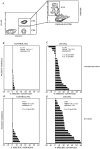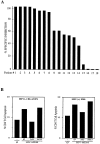Macrophage-dependent apoptosis of CD4+ T lymphocytes from HIV-infected individuals is mediated by FasL and tumor necrosis factor
- PMID: 8996241
- PMCID: PMC2196110
- DOI: 10.1084/jem.185.1.55
Macrophage-dependent apoptosis of CD4+ T lymphocytes from HIV-infected individuals is mediated by FasL and tumor necrosis factor
Abstract
Apoptosis of bystander uninfected CD4+ T lymphocytes by neighboring HIV-infected cells is observed in cell culture and in lymphoid tissue of HIV-infected individuals. This study addresses whether antigen-presenting cells such as human macrophages mediate apoptosis of CD4+ T cells from HIV-infected individuals. Uninfected human macrophages, and to a larger degree, HIV-infected macrophages mediate apoptosis of T cells from HIV-infected, but not from uninfected control individuals. This macrophage-dependent killing targets CD4+, but not CD8+ T lymphocytes from HIV-infected individuals, and direct contact between macrophages and lymphocytes is required. Additional analyses indicated that the apoptosis-inducing ligands, FasL and tumor necrosis factor (TNF), mediate this macrophage-induced apoptosis of CD4+ T cells. These results support a role for macrophage-associated FasL and TNF in the selective depletion of CD4+ T cells in HIV-infected individuals.
Figures





References
-
- Krammer PH, Behrmann I, Daniel P, Dhein J, Debatin K-M. Regulation of apoptosis in the immune system. Curr Opin Immunol. 1994;6:279–289. - PubMed
-
- Alderson MR, Tough TW, Braddy S, Davis T, Smith, Roux E, Schooley K, Miller RE, Lynch DH. Regulation of apoptosis and T cell activation by Fas-specific mAb. Int Immunol. 1994;6:1799–1806. - PubMed
-
- Dhein J, Walczak H, Bäumler C, Debatin K-M, Krammer PH. Autocrine T-cell suicide mediated by APO-1/(Fas/CD95) Nature (Lond) 1995;373:438–441. - PubMed
-
- Brunner T, Mogil RJ, LaFace D, Yoo NJ, Mahboubi A, Echeverri F, Martin SJ, Force WR, Lynch DH, Ware CF, Green DR. Cell-autonomous Fas (CD95)/Fasligand interaction mediates activation-induced apoptosis in T-cell hybridomas. Nature (Lond) 1995;373:441–444. - PubMed
MeSH terms
Substances
LinkOut - more resources
Full Text Sources
Other Literature Sources
Medical
Research Materials

